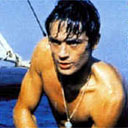
Author: Born in Texas, Patricia Highsmith (1921-1995) grew up in New York, raised by her grandmother after her parents separated. Her first novel, Strangers on a Train (1950), made an immediate impact, especially after Alfred Hitchcock released his celebrated film adaptation in 1951. Highsmith created her most enduring character with The Talented Mr Ripley (1955) which spawned a number of sequels - Ripley Under Ground (1970), Ripley's Game (1974), The Boy Who Followed Ripley (1980), and Ripley Under Water (1991). Highsmith led a flamboyant lesbian lifestyle, and left America for Europe in 1963. She lived first in England, then moved around regularly before settling in Locarno in Switzerland. She was diagnosed with lung cancer in the early 1990s.
The story: Tom Ripley, an impecunious but ambitious American, secures a trip to Europe to look up a tenuous acquaintance of his, Dickie Greenleaf, and persuade him to return to the US. Ripley hardly knows Greenleaf, but insinuates himself into his bohemian life in the Italian village of Mongibello. Look-ing for financial and social advantage, he drives a wedge between Greenleaf and his friends - principally Marge, a writer - and the two men head off travelling together. Ripley kills Greenleaf on a boat trip, then assumes his identity and begins living the lifestyle to which he has always aspired. Ripley then murders Freddie Miles, another friend of Greenleaf, after his suspicions are aroused. Finally, Ripley forges Greenleaf's will, inherits his money, and ultimately escapes any consequences for his actions.
The film-makers: Initially an architecture student, René Clément (1913-1996) began writing for Jacques Tati in the 1930s, before breaking into features with the Resistance drama La Bataille du Rail (1946). The success of Gervaise (1956) saw him co-opted into Hollywood in a big way - The Sea Wall (1958), The Love Cage (1963). The French-language Plein Soleil (1960) was very much out of step with his later career. The little-known Alain Delon was cast in the lead role - and it was the combination of Plein Soleil and Rocco and His Brothers (1960) that propelled Delon to stardom.
How the book and film compare: Plein Soleil skips over The Talented Mr Ripley 's early chapters, excising Ripley's encounter with Greenleaf's father and his awkward arrival in Mongibello. The film dilutes the sexual ambiguities of the novel - both Greenleaf and Ripley are very heterosexual, emphasised in a scene when they pick up a local woman for a carriage ride. Consequently the Marge character plays a very different role - in the book, she is an unrequited lover of Greenleaf, while in the film they are having a tempestuous relationship. Much of the film's action takes place on a yacht - which is central to the film's shock ending.
Inspirations and influences: The Italian "dolce vita" lifestyle was arguably the dominant social phenomenon of the period. The claustrophobic boat-set love triangle would soon find a more direct treatment in Roman Polanski's debut film Knife in the Water (1962). The Ripley novels would remain of enduring interest to film-makers, with high points being Wim Wenders's oblique adaptation of Ripley's Game , The American Friend (1977), and Anthony Minghella's faithful treatment, The Talented Mr Ripley (1999).

